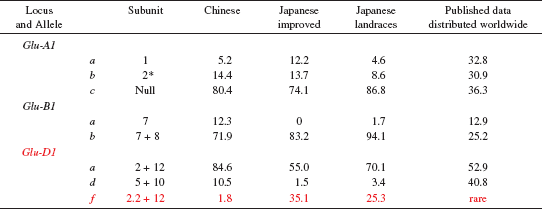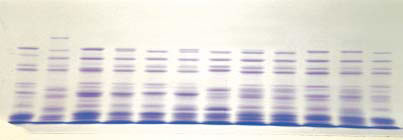The specific glutenin Glu-1 allele frequencies of Japanese hexaploid wheat (Triticum aestivum L.)
Description
[Objectives]
The objective was to analyze this distribution in Japan that the most geographically remote region for common wheat production, concentrating mainly on HMW glutenin allelic variation within common wheat, and the factors which affect it in a worldwide context.
[Results]
According to a study of the worldwide distribution of Glu-1 alleles in hexaploid wheats, the Glu-D1f is rare. However, the Glu-D1f allele was the most abundant hexaploid Japanese wheat seed storage protein allele (Table 1, Fig. 1). The present study revealed the specific differences in frequency of the Glu-D1f allele for Japanese hexaploid wheat varieties and landraces. The allelic frequency of this subunit was shown to have a 35% excess among improved Japanese cultivars and 25.3% among Japanese landraces, while it was found in only 1.8% of 274 Chinese wheats targeted in this study. It is well known that the Chinese wheat has contributed to the development of Japanese landraces, and Japanese landraces led to the emergence of modern varieties now found Japan. However, from this study, it has become apparent that Japanese and Chinese hexaploid wheats differ a great deal in the frequencies of the Glu-D1f allele (Table 1). As a consequence of its dissemination, adaptation and phenotypic refinement, Japanese hexaploid wheat has developed a unique composition of Glu-1 glutenin alleles and a narrow hexaploid wheat genetic base (Table 2). Each of these bottlenecks is followed by a flush of rapid population growth, so once again there are optimal conditions to include genetic alterations. With this design from China, the hexaploid wheats were exposed to a selective bottleneck induced by the external environment, as well as a founder effect (since all populations went through small bottlenecks). Consequently, the selective bottleneck was extremely intense and, in fact, most ancestral populations may become extinct in Japan. It should also be pointed out that although the selective bottlenecks discussed in this study were primarily induced by genetic environment, most of the predictions made in this study would also apply if the selective bottlenecks were induced by external environments. The ease with which genetic changes occur in Japan strongly implies a lack of genetic variability in natural populations of Japanese hexaploid wheats. The theory presented here has increased the explanatory powers of the wheat genetic revolution model of speciation and, more importantly, has generated testable hypotheses that can be investigated in both natural and artificial selections using current methodologies and systems.
Figure, table
-
Table 1. Frequencies (%) of alleles for loci Glu-A1, Glu-B1 and Glu-D1 in Japanese and Chinese varieties.
-
Fig. 1. SDS-gel electrophoresis of common wheat seed storage proteins. -
Table 2. Identification of Japanese and Chinese varieties with respect to HMW glutenin allele composition.
- Affiliation
-
Japan International Research Center for Agricultural Sciences Food Science and Technology Division
- Classification
-
Technical A
- Term of research
-
FY2002-2003 (FY2002-2005)
- Responsible researcher
-
NAKAMURA Hiro ( Food Science and Technology Division )
- ほか
- Publication, etc.
-
Nakamura, H. and Fujimaki, H. (2002): The specific Glu-D1f allele frequency in Japanese hexaploid wheat. Cereal Chemistry, 79(4), 486-490.
Nakamura, H. and Fujimaki, H. (2003): By reason of the founder effect or a selective bottleneck, the specific alleles frequency of Japanese hexaploid wheat (Triticum aestivum L.) compared to the worldwide distribution of Glu-1 alleles. 10th International Wheat Genetics Symposium, 1, 459-462.
Nakamura, H. (2004): The Specific Glutenin Allele frequencies of Japanese Common Wheat: An Overview. Recent Research Development in Biochemistry, 5, 81-87.
- Japanese PDF
-
2003_23_A3_ja.pdf2.12 MB
- English PDF
-
2003_23_A4_en.pdf69.89 KB



